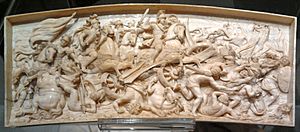Publius Cornelius Scipio (consul 218 BC) facts for kids

Publius Cornelius Scipio was an important Roman general and politician. He lived a long time ago, dying in 211 BC. He was also the father of a very famous general named Scipio Africanus. Publius Cornelius Scipio played a big role in the Second Punic War, a huge conflict between Rome and its enemy, Carthage.
Contents
Early Life and First Steps in War
Publius Cornelius Scipio belonged to a powerful Roman family called the Cornelia gens. In 218 BC, he became a consul, which was one of the highest political jobs in the Roman Republic. This was also the very first year of the Second Punic War.
At the start of the war, Scipio was given a big job. He was ordered to lead the Roman army in the Iberian Peninsula (modern-day Spain and Portugal). His main goal was to stop Hannibal, the famous Carthaginian general. Meanwhile, the other consul, Tiberius Sempronius Longus, was sent to Sicily and Africa.
Scipio was given a large army. He had two Roman legions, which are big groups of soldiers. He also had 14,000 allied foot soldiers and 1,600 allied horse soldiers. Plus, he had 60 quinqueremes, which were large warships.
Chasing Hannibal and Returning to Italy
Scipio set sail with his army from Pisa, planning to meet Hannibal in Hispania. But when he stopped at Massalia (now Marseille, France) to get more supplies, he got a big surprise! He found out that Hannibal's army had already left Hispania and was crossing the Rhône River.
Scipio quickly landed his army and marched to find Hannibal. But Hannibal had already moved on. So, Scipio went back to his ships. He decided to send his army to Hispania with his brother, Gnaeus Cornelius Scipio Calvus. His brother would continue the original mission there. Scipio himself returned to Italy to lead the Roman troops fighting in Cisalpine Gaul (northern Italy).
Battles in Italy
When Scipio arrived back in Italy, he immediately went to meet Hannibal. They had a fierce fight involving horse soldiers near the Ticinus River, which flows into the Po. Scipio's army was defeated, and he was badly hurt.
Later that year, in December, Scipio saw another terrible defeat for the Roman army. This happened at the Trebia River. It is said that his fellow consul, Tiberius Sempronius Longus, insisted on fighting even though Scipio advised against it.
Successes and Final Defeat in Hispania
Even after these military losses, the Roman people still trusted Scipio. His command was extended, meaning he stayed in charge. The next year, he was back in Hispania with his brother Calvus. They won many battles against the Carthaginians. This helped Rome become stronger in the Iberian Peninsula.
Scipio continued fighting in Hispania until 211 BC. Sadly, he was killed during a battle near the Upper Baetis River. His army was defeated by the Carthaginians and their Iberian allies, led by Indibilis and Mandonius. In the same year, his brother Calvus and his army were also destroyed near Ilorci, close to Carthago Nova.
We don't know all the details of these battles. But it seems that the two Scipio brothers lost because some of their allies, the Celtiberians, switched sides. Hannibal's brother, Hasdrubal Barca, had bribed them to desert.
A Strange Event
At Scipio's funeral, a man named Lucius Marcius was giving a speech. Suddenly, his head seemed to catch fire all by itself! People at the time believed this was a special message from the gods. They thought it was a sign for Scipio's soldiers to get revenge for his death.
Publius Cornelius Scipio was the son of Lucius Cornelius Scipio. Besides Publius Cornelius Scipio Africanus, he was also the father of Lucius Cornelius Scipio Asiaticus.
See also
 In Spanish: Publio Cornelio Escipión (cónsul 218 a. C.) para niños
In Spanish: Publio Cornelio Escipión (cónsul 218 a. C.) para niños
- Scipio-Paullus-Gracchus family tree

